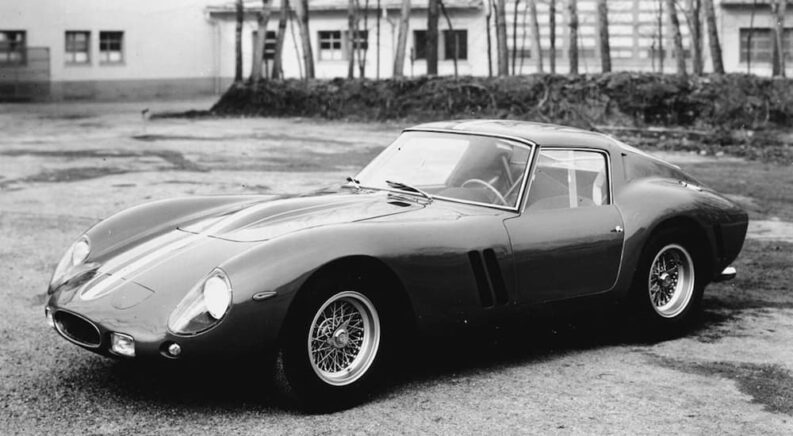In November of 2022, a collection of 18 cars was auctioned off by RM Sotheby’s of London. Although 18 vehicles are hardly impressive by the standards of the world’s great car collectors, this was no aggregation of garden-variety classics, muscle cars, and grand tourers; every one of the 18 carried significant clout in the automotive industry. Dubbed the “Gran Turismo Collection,” this roster included incredibly significant Group B racers, top speed record holders, and the entire lineup of Ferrari supercars.
I’ll be stopping to smell the roses with each of these cars, starting with the unequivocal highlight: the Ferrari supercar quintet. I’ve covered before the Enzo Ferrari, F50, and F40, and now I shall move on to the car that started it all nearly 40 years ago: the Ferrari GTO (better known as the 288 GTO, to avoid confusion with the 250 GTO). This understated supercar is now one of the most valuable Ferraris on the market, with perfect style, excellent performance, titanic significance, and is of the utmost rarity. Somewhat overshadowed by its descendants and the iconic, visually similar—and far more common—308 and Testarossa (which were popular simultaneously), the 288 GTO deserves every bit of spotlight it can get. So let’s give it some more.
Maranello Vice
In the early 1980s, Enzo Ferrari had a problem. Not a “success” problem—his company had made thousands of cars throughout the 1970s—but more of an identity crisis. They were offering so many coupes and convertibles with engines under 200 hp and no racing credibility, and for a brand whose identity was built around racing! This is the marque that sells on Monday to race on Sunday, dang it! Enzo demanded the production of something exclusive and worthy of the Ferrari legacy—and the result was the GTO.
As chief engineer Nicola Materazzi put it, this car “truly meant the rebirth of the ‘real’ Ferrari.” It existed solely to compete in Group B rally racing (or, more specifically, to properly homologate the vehicle that would compete to satisfy league requirements). It certainly looked familiar—the design was largely an evolution of the 308 and even the Berlinetta Boxer. Even the stripped-down interior retained enough luxury to be recognizable, and the ride quality has been reported as surprisingly gentle. One would not expect the F50 to dampen the effects of road imperfections, and yet the GTO achieved just that!
But underneath this familiar exterior was a new beast altogether, engineered to compete. The tube frame chassis was covered in composite bodywork; even the seats were Kevlar-framed. This bodywork was adjusted to position the wheels farther apart than on the 308, covered in functional air vents, and the engine—Ferrari’s first production twin-turbo and their first road car with a longitudinally mounted V8 engine—hailed from Lancia’s prototype-class Group C racing program. This engine was mounted so far forward that it encroached upon the cabin space (which did have an engine access panel), all in the name of weight distribution.
So it was that the GTO came to set a benchmark for Ferrari engineering while looking every bit the part of a supporting role in Miami Vice. Viewed by some as the most exciting car ever made, it balanced genuine race car performance with shades of the luxury that Ferrari had become known for. With the primary interest being racing (not selling cars), its official run of 272 examples makes it the rarest Ferrari supercar.
Mission Accomplished
The Group B mission—everyone’s, not just Enzo Ferrari’s—was tragically flawed. With virtually no limitations on, well, anything, competitors got into an arms race of epic proportions, creating some of the most exciting (and most dangerous) vehicles ever made. At the end of the day, safety was too far from the mind and, with an unacceptable casualty rate, FISA suspended the class after only four years to prevent further loss of life. The Ferrari GTO was just a little too late to the party to be let in, and the model never raced.
Despite this objective failure of the Ferrari Group B racing program, all 200 allocations of the vehicle had sold before they were ever built. Ferrari increased allocations to 272 (formally) and successfully restored the brand’s image as a racing company first, vehicle manufacturer second—as if that image was ever really in any doubt. The twin-turbo 2.9L V8 was Ferrari’s most powerful production engine, making roughly 400 hp at 7000 RPM while shunting 366 lb-ft at 3800 RPM. The power came on gradually, almost tamely, compared to other old turbo designs, and the wide placement of the wheels and excellent balance kept the car under control in virtually any circumstance.
Returning to exclusive production runs of ludicrously high-performance vehicles demonstrated a rabid market for supercars that small-volume builders have been able to capitalize on for decades since. Ferrari’s identity as a performance brand has never come into question, and for those who’ve invested in buying and maintaining a GTO, the payoff has been tremendous. Since its creation, the car has appreciated by a factor of nearly 17—a linear rate of return exceeding 225% year over year! Even subjecting the car to mileage doesn’t significantly hamper its value; for further proof, look at what’s to come for Chassis #56339.
Chassis #56339
This is the car that was up for auction in November. Produced in the middle of the GTO’s short production run (as #177 of 272), this particular vehicle was sold into one of the most interesting ownership arrangements I’ve ever heard of, being jointly owned by doctors in New York and Austria! In its first month of life, this car took a road trip across Europe, exceeding 3,100 km (1,900 miles) in that short span. Whew! Talk about breaking it in!
Though it was documented as being transferred to the other owner in 1986, the car never left European shores; instead, the US-based owner drove it up and down the Italian coast with New York plates until the year 2000! The New Yorker bought the Austrian out of the car in 1991 and, based on the mileage reported in 2009 (seven years after it was sold to a Dutch importer), the New Yorker had put it through over 400 miles per year. Just imagine the annual road trip he took between Naples and Rome in that 288 GTO; that gorgeous car surrounded by such beautiful scenery, all under the Mediterranean sun, is like something straight out of a movie!
It wasn’t meant to last, however; this GTO was sold again, and the importer who held it saw that it was looked after. From 2006 to 2009, over $5,000 in maintenance expenses were added to the cost, as the importer gave the GTO the care it needed (also to ensure the next owner’s satisfaction); this was followed by an inspection by world-renowned Ferrari expert Marcel Massini and Classiche certification in 2010, identifying that this car met its original factory specifications and standards, and that its core components were all original to this chassis.
Owner #3 would bring the car to the UK and, surely, to their chagrin, commit significant expenses to maintain it. The engine, gearbox, and engine bay were steam cleaned; the turbochargers were rebuilt, and major maintenance service was performed, exceeding $12,000 USD over the span of barely a year, from July 2010 to 2011. It changed hands to its current owner via Talacrest over the winter of 2011-12.
Valve timing was adjusted, the coolant system was restored, and the car entered the Gran Turismo collection in 2012, rounding out what was then the Ferrari supercar quartet for this owner’s collection. They promptly got to work doing what they seemed to do best: driving their supercars. I mentioned earlier that 18 isn’t big in the major leagues of car collecting, but for the average human, that’s more than we’ll own in our lifetimes. So I find it impressive that none of these Ferraris have been mothballed in their time here. This particular GTO has racked up over 800 km/year (500 miles/year) in its decade with Owner #4.
With mileage comes maintenance, of course. In 2017 over $17,000 of maintenance was performed to replace the clutch, belts, and more; then again, in 2022, the clutch release bearing was replaced, and the bell housing was resealed to the tune of $5,000. With these extensive maintenance records, Classiche certification, and the complete set of Ferrari “swag” that comes with the car, there are no gaps and no unknowns with this example! Although it exceeds the average mileage for auctioned GTOs by nearly 50%, it’s expected to eventually sell for nearly $4,000,000 USD! For a car with no storage solutions to speak of, few creature comforts, a demanding manual transmission, and massive maintenance costs, seeing action equivalent to monthly day trips is precisely what it was meant to do! Most owners would be afraid of clocking such numbers, or wouldn’t be interested in doing more than displaying it in a garage, but this particular GTO is getting the exact treatment I think Enzo would have wanted for it.
Ferrari’s Keystone Car
When the auction closed last November, the F50 and GTO remained unsold, perhaps unsurprisingly, given their astronomical projected sale prices. Chassis #56339 was expected to sell for upwards of $4,000,000, and one day it probably will. I think it’s likely to continue experiencing above-average mileage, and that’s a happy thought; although the quintet is no longer together, this car remains in a happy home.
As perhaps the only Ferrari supercar that could be considered “understated,” the 288 GTO’s rarity—and the prevalence of the lookalike on which it’s based, thanks to pop culture influences like Miami Vice—allowed it to slip under the radar in its youth. But no longer! With a simple, elegant, and downright cool style, an incredibly significant powertrain, and a balance of performance with usability that one is unlikely to find in any other supercar of the era, the Ferrari GTO is undoubtedly one of the most exciting cars ever made.
Not necessarily for what it can do—even a suped-up Suburu can beat a 4.9 second zero-to-sixty time these days—but for how it does it, for what it was designed to do, and for what would follow in its footsteps. The F40—or, at least, the cultural tsunami it created—likely wouldn’t have been possible without the success of this one model. That makes it one of the most important cars Ferrari has ever made, a true rebirthing of the brand name, a perfect inheritor of the marque’s most prestigious badge: GTO.




